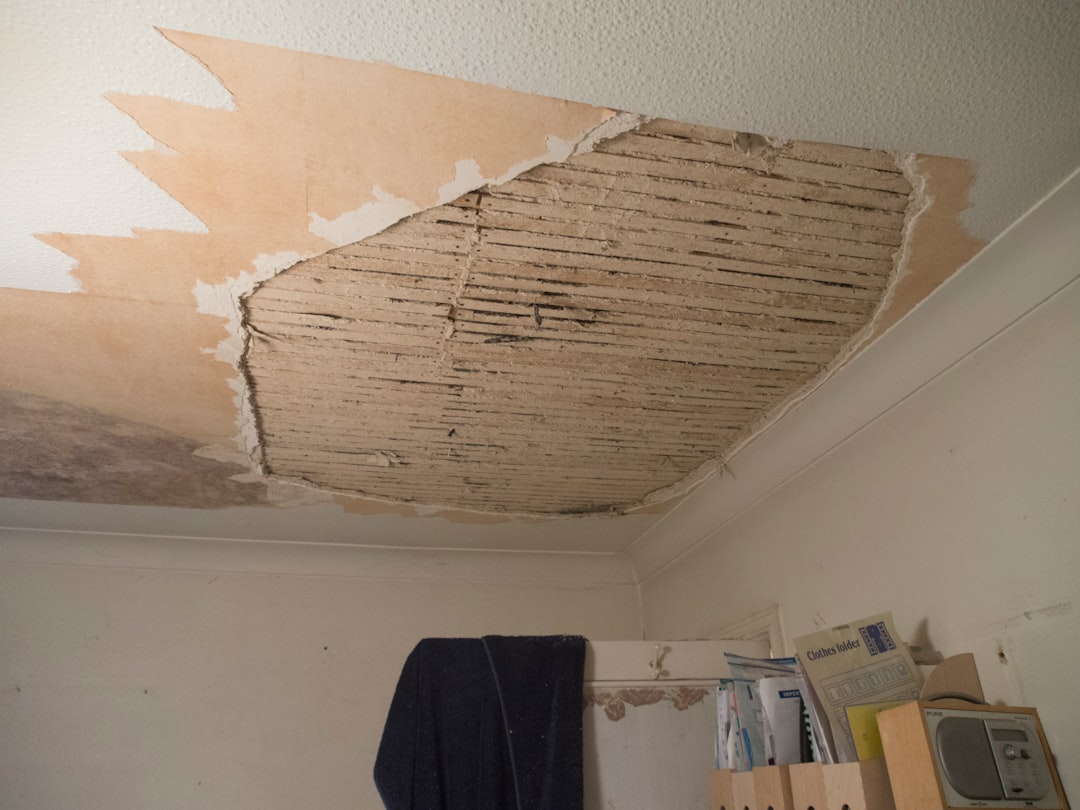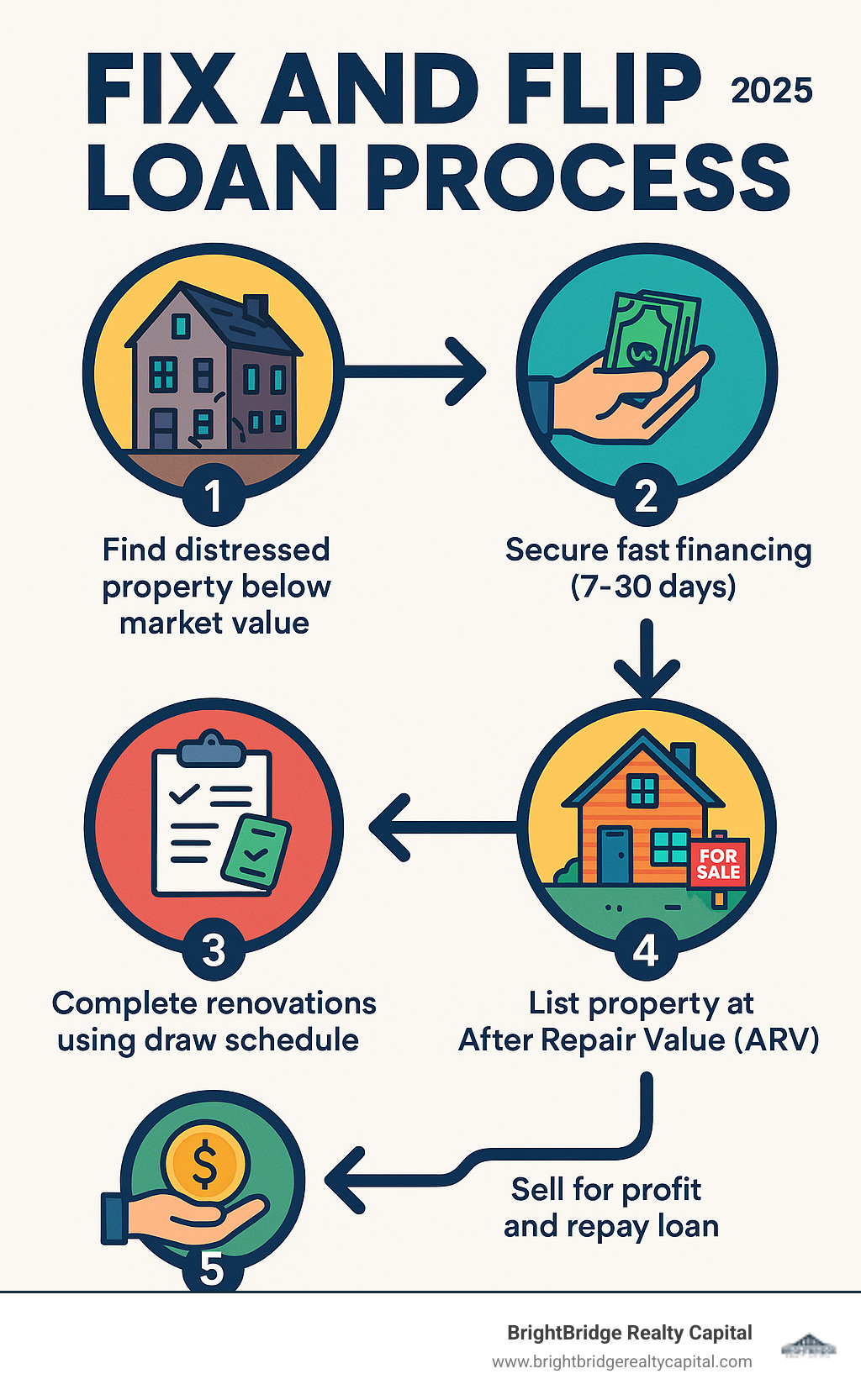Don't Get Flustered: Find Your Perfect Fix and Flip Lender Here

Your Guide to Fix and Flip Financing
Fix and flip property lenders offer short-term financing for real estate investors who buy, renovate, and sell properties for profit. These lenders understand the needs of house flippers, providing faster approvals, flexible terms, and higher leverage than traditional mortgages.
Common Types of Fix and Flip Lenders:
- Hard Money Lenders: Known for speed, they focus on the property's value rather than borrower credit and can close in days.
- Private Capital Lenders: Offer competitive rates and high leverage, often funding both purchase and rehab costs.
- Bridge Loan Specialists: Provide short-term financing to bridge the gap between buying a property and securing long-term funding or selling it.
Key Features to Compare:
- Loan amounts: $75K - $5M+
- Interest rates: 7.75% - 12%+
- Closing speed: 48 hours - 30 days
- Leverage: Up to 95% purchase price + 100% rehab costs
- Terms: 6-24 months with interest-only payments
The real estate market moves fast, and investors need financing that can keep pace. As one industry expert noted, "fixing houses is a roller coaster of an industry"—you need lenders who understand the market's ebb and flow.
Whether you're a first-time flipper or managing multiple projects, choosing the right lender can make or break your deal. Speed is crucial when competing with cash buyers, but so are reliable terms and transparent fees.
I'm Daniel Lopez, a loan officer at BrightBridge Realty Capital with extensive experience helping investors steer fix and flip property lenders. I've seen how the right lender partnership can transform an investor's business and maximize returns.

Understanding the Different Types of Fix and Flip Financing
Choosing the right financing is crucial for your fix and flip project. Each loan type has a specific purpose, and understanding them helps you find the perfect match for your investment strategy. Let's review the main options.
Hard Money Loans
Hard money loans are built for speed and flexibility, often closing in 7-14 days, with some lenders funding in as little as 48 hours. Their asset-based lending approach focuses on the property's potential After Repair Value (ARV) rather than just your credit score. This makes them ideal for distressed properties that traditional banks avoid.
The trade-off for this speed is higher interest rates (typically 8% to 12%+) and short terms of 6-18 months. However, when you need to close quickly on a great deal, the fast closing of 7-14 days provides a significant competitive edge in hot markets.
More info about fix-and-flip loans
Residential Transition Loans (RTLs)
RTLs, which come from private capital sources, often provide more competitive rates than hard money loans. They are an excellent option because they can cover up to 90% of your purchase price and 100% of your rehab costs. This high leverage allows you to take on bigger projects with less cash upfront.
RTLs typically have 12-24 month terms, offering more time than hard money loans. They involve structured underwriting, which is more detailed than hard money but still much faster than a bank. These loans are perfect for experienced investors looking to scale their operations by tackling larger or multiple projects simultaneously.
Bank-Style Loans
While bank-style loans offer lower interest rates, they come with significant drawbacks for flippers. The stricter requirements include a high credit score of 680+, extensive documentation, and properties needing only minor cosmetic work.
The biggest hurdle is the longer approval process of 30-60 days. In a fast-moving market, this delay means you could easily lose a property to an investor with faster financing. For these reasons, bank loans are not ideal for speed and are unsuitable for most true fix and flip projects.
Using Your Own Equity (HELOC & Cash-Out Refinance)
Your home's equity can be a source of funding for a flip. A Home Equity Line of Credit (HELOC) acts like a credit card secured by your home, allowing you to draw funds as needed for renovations. It typically has variable rates.
A cash-out refinance replaces your current mortgage with a new, larger one, giving you the difference in a lump sum. Both options have lower upfront costs than hard money loans. However, they place your primary residence at risk. If the flip project fails, your home could be in jeopardy. If you choose this path, ensure you have a solid plan and significant cash reserves to protect your primary asset.
What to Look for in Fix and Flip Property Lenders
Selecting the right lender is as important as finding the right property. It's not just about getting money; it's about partnering with a source that understands your business and can help you succeed.
Key Traits of Top-Tier Fix and Flip Property Lenders

Here's what separates the best fix and flip property lenders from the rest:
- Speed to close: The best lenders can close in 48 hours to two weeks, giving you a competitive advantage over cash buyers and those using slower, traditional financing.
- Transparency: A good lender is upfront about all costs. There should be no hidden fees, surprise charges, or last-minute changes to your terms.
- Communication: Look for a responsive partner who provides clear updates throughout the process. Good communication is vital when you're managing a time-sensitive project.
- Experience: Lenders specializing in real estate investing understand the market's unique challenges and can offer valuable guidance beyond just funding.
- Reliability: A reliable lender has capital ready and funds draws on schedule, acting as a true partner who helps you scale your business.
- In-house servicing: Lenders who handle processing, underwriting, and servicing internally often provide a faster, more streamlined experience.
Building a strong relationship with the right lender is an investment that pays dividends across multiple deals.
Check a lender's licenseMore info about bridge loans
Evaluating Loan Terms, Rates, and Fees
Understanding the financial details is essential for protecting your profit margins. Here's what to look for:
- Interest rates: Typically 8% to 12%+, depending on the lender and your experience. Always compare the Annual Percentage Rate (APR) for the true cost.
- Origination points: These are upfront fees of 1-3% of the loan amount, paid at closing. Sometimes paying points is worthwhile for better terms or faster service.
- Loan-to-Cost (LTC): This ratio shows how much of the total project cost is financed. High LTCs (e.g., 90% purchase + 100% rehab) mean less cash out of pocket.
- Loan-to-Value (LTV): Based on the property's current value or After-Repair Value (ARV), this is usually capped at 70-80% of ARV to create a safety buffer.
- Prepayment penalties: The best lenders don't charge these, as the goal of a flip is a quick sale.
- Draw fees: These are charges for releasing renovation funds. They should be reasonable and clearly disclosed.
- Junk fees: Beware of excessive or vaguely described charges. Reputable lenders have transparent fee structures.
The Crucial Role of After-Repair Value (ARV)
The After-Repair Value (ARV) is central to fix and flip lending, as it projects the property's worth post-renovation.
- ARV calculation: This drives the lending decision. Lenders base their loan amounts on the projected ARV to ensure there's enough equity to secure the loan and your profit.
- Lender's appraisal: The lender will order an appraisal to assess the property's potential, reviewing your Scope of Work (SOW) and comparing it to similar renovated properties.
- Basis for loan amount: The ARV determines the maximum loan you can receive. For example, a 75% LTV on a $300,000 ARV could mean a loan of up to $225,000.
- Profitability assessment: For you, the ARV is critical for ensuring your costs (purchase, rehab, fees) leave a healthy profit margin.
- Exit strategy: A realistic ARV gives you confidence that the property will sell at your target price, allowing you to repay the loan and move to the next project.
A solid, realistic ARV is the foundation of a successful flip. Smart lenders won't proceed without one—and neither should you.
The Fix and Flip Loan Process from Application to Closing
Once you've found a property and crunched the numbers, it's time to secure financing. The fix and flip loan process is a clear roadmap from application to funding. Let's walk through what to expect.
Eligibility and Required Documentation
Lender criteria can vary, but most fix and flip property lenders evaluate similar factors. Hard money lenders focus more on the deal's potential, while banks have stricter personal financial requirements.
| Requirement | Hard Money / Private Lenders | Bank-Style Loans |
|---|---|---|
| Credit Score | Lower, sometimes as low as 600-660. Focus on property potential. | Higher, typically 680+. Emphasis on borrower's financial history. |
| Down Payment | Varies, but often 10-20% of purchase price. | Can be higher, and often requires more cash out of pocket. |
| Experience | Can work with first-time flippers, but seasoned investors get better terms. | Generally prefers experienced borrowers with strong financial profiles. |
| Property Condition | Ideal for distressed properties needing significant repairs (the "fixer-uppers"). | Prefers properties in good condition, requiring minimal repairs. |
| Speed | Very fast, often 48 hours to 2 weeks for funding. | Slow, 30-60 days for approval. |
To apply, you'll need key documents to demonstrate the viability of your project and your ability to execute it. Be prepared with:
- Business entity documents (e.g., LLC or corporation paperwork)
- The purchase contract for the property
- A detailed renovation budget/Scope of Work (SOW)
- Asset verification to prove you have funds for the down payment, closing costs, and reserves
Navigating the Application with Fix and Flip Property Lenders
The application process with fix and flip property lenders follows a clear path:
- Pre-qualification: An initial review of your project and finances to estimate what you might qualify for.
- Term Sheet: If you pre-qualify, the lender issues a written outline of the proposed loan terms, including amount, rate, and points.
- Underwriting: The lender conducts a deep dive, reviewing your documents, experience, credit, and background.
- Appraisal/Valuation: An appraisal is ordered to determine the property's "as-is" value and its projected After Repair Value (ARV), which solidifies the loan amount.
- Title and Escrow: A title company searches for liens or issues with the property and manages the secure holding of funds until closing.
- Clear to Close: Once all conditions are met, you are officially approved.
The funding timeline is where specialized lenders excel. While bank loans take 30-60 days, hard money and private loans can close in 48 hours to two weeks, which is critical for competing against cash buyers.
How Renovation Costs Are Funded
Fix and flip loans often cover up to 100% of renovation costs through a draw schedule.
Here's how it works: renovation funds are held in escrow and released in stages, or "draws," as you complete project milestones (e.g., demolition, plumbing, final finishes). After completing a stage, you request a draw. The lender sends an inspector to verify the work, and upon approval, the funds for that stage are released to you. This structured system protects both you and the lender by ensuring funds are used as intended and that the property's value increases with the work completed.
More info about construction loans
Frequently Asked Questions about Fix and Flip Lenders
Investors often have similar questions about fix and flip property lenders. Here are answers to the most common ones we encounter.
How quickly can I get a fix and flip loan?
Speed is critical in real estate investing. Specialized fix and flip property lenders understand this and can close deals in as little as 48 hours to two weeks. This gives you a major competitive edge against other buyers, especially those using traditional bank loans that take 30-60 days. At BrightBridge Realty Capital, we prioritize fast closings, often within a week, because we know timing can make or break your deal.
Can I get a fix and flip loan with no experience?
Yes, many lenders work with first-time flippers. Hard money and private capital lenders focus more on the property's profit potential (its After Repair Value, or ARV) than your flipping history. To succeed, you'll need a solid renovation plan, a realistic budget, and cash reserves for unexpected costs. Demonstrating that you've done your homework and have a clear path to profit is key, even if your credit score isn't perfect.
Do these loans cover both the purchase and the rehab?
Yes, this is a primary benefit of fix and flip loans. Most are structured to finance a high percentage of the purchase price (up to 90-95%) and up to 100% of the renovation costs in one package. This reduces your out-of-pocket cash requirement. The rehab funds are held in escrow and released in stages (draws) as you complete and verify construction milestones, ensuring the project stays on track and on budget.
Partner with the Right Lender to Maximize Your ROI
You've learned a lot about the different types of financing and what makes a great fix and flip property lenders. Now, let's bring it all together. Finding the right funding isn't just about getting money; it's about open uping your project's full potential. The right lender truly becomes a valuable partner in your real estate journey.
Imagine a lender who truly understands that in fix and flip, speed is everything. They offer flexible terms that fit your unique project, and they provide reliable capital you can always count on. This kind of partnership lets you quickly seize those amazing opportunities, complete your renovations smoothly, and ultimately, achieve your financial goals.
At BrightBridge Realty Capital, we pride ourselves on being that direct lender for investors like you. We specialize in fast closings and customized solutions, because we know every deal is different. We bring the expertise and the capital needed to get your project done efficiently.
We see ourselves as more than just a lender. We're a partner from beginning to end. Your success isn't just a goal for you; it's our success too. Let us help you steer the financing landscape with confidence and ease.
Ready to take the next step and transform your investment dreams into reality?




